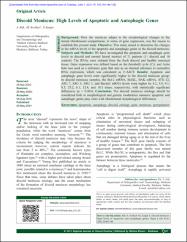Discoid meniscus: High levels of apoptotic and autophagic genes

Göster/
Erişim
info:eu-repo/semantics/openAccessAttribution-NonCommercial-ShareAlike 3.0 United Stateshttp://creativecommons.org/licenses/by-nc-sa/3.0/us/Tarih
2021Üst veri
Tüm öğe kaydını gösterÖzet
Background: How the meniscus adapts to the morphological changes in the lateral tibiofemoral compartment, in terms of gene expression, was the reason to establish this present study. Objective: This study aimed to determine the changes in the mRNA levels of the apoptotic and autophagic genes in the discoid meniscus. Subjects and Methods: We have investigated the apoptotic and autophagic gene levels in discoid and normal lateral menisci of 21 patients (11 discoid and 10 control). The RNAs were isolated from the fresh discoid and healthy meniscal tissue. Gene expression was defined based on the threshold cycle (Ct), and Actin beta was used as a reference gene that acts as an internal reference to normalize RNA expression, which was calculated as 2-Delta Delta CT. Results: Apoptotic and autophagic gene levels were significantly higher in the discoid meniscus group. In discoid meniscus samples, the Bcl-2 mRNA, BclXL, BAK mRNA, ATG 12, ATG 7, ATG 5, ATG 3, and Beclin1 mRNA levels were higher by 4.2, 5.9, 9.1, 8.3, 23.2, 6.1, 12.4, and 18.1 times, respectively, with statistically significant differences (p < 0.001). Conclusion: The discoid meniscus etiology should be considered both in morphological and genetic modulation manners: apoptotic and autophagic genes play roles with tibiofemoral morphological differences.
Kaynak
Nigerian Journal of Clinical PracticeCilt
24Sayı
5Koleksiyonlar
Aşağıdaki lisans dosyası bu öğe ile ilişkilidir:


















